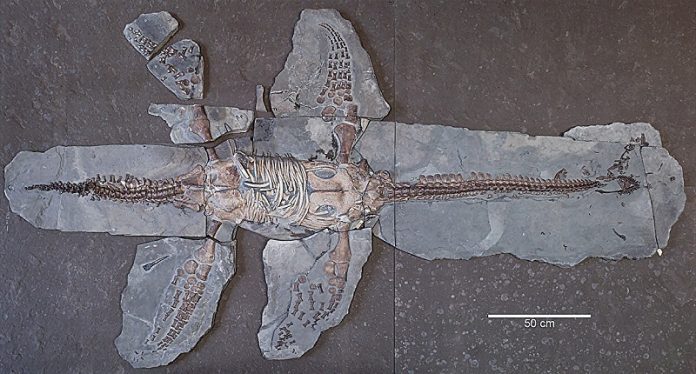
Credit: PeerJ (2025).
A newly discovered fossil from Germany is helping scientists understand how ancient marine reptiles called plesiosaurs evolved and spread across Europe nearly 180 million years ago.
The fossil, described in a new study published in [_PeerJ_](https://peerj.com/articles/18960/), belongs to a species called _Plesiopterys wildi_.
It was found in southern Germany, in an area known for its well-preserved fossils from the Early Jurassic period.
This particular fossil, named MH 7, is one of the most complete plesiosaur skeletons ever found in the region.
Plesiosaurs were long-necked reptiles that lived in the ocean during the time of the dinosaurs. While the area where this fossil was found—called the Posidonienschiefer Formation near Holzmaden—is famous for marine reptiles like ichthyosaurs and ancient crocodile relatives, plesiosaurs are rarely found there.
That makes this discovery especially important.
MH 7 is a subadult, meaning it wasn’t fully grown, but it still gives researchers valuable information about the species. The fossil helps confirm that _Plesiopterys wildi_ is a unique species and not just a young version of another type of plesiosaur.
Researchers also used the fossil to better understand where this species fits in the plesiosaur family tree. Their analysis shows that _Plesiopterys wildi_ was one of the earlier members of the plesiosaur group, closely related to another rare species called _Franconiasaurus brevispinus_.
This connection suggests that early plesiosaurs gradually evolved into more advanced types that later became common in the Late Jurassic period.
The fossil also supports the idea that different plesiosaur species may have lived in separate regions of the ancient European seas. This pattern, known as “paleobiogeographical segregation,” means that marine life may have been more locally unique than scientists previously thought.
“The Holzmaden specimen gives us a rare chance to study _Plesiopterys wildi_ at a more advanced growth stage,” said lead author Miguel Marx from Lund University. “It helps us understand both how the species developed and how plesiosaurs evolved more broadly.”
Co-author Sven Sachs added, “This discovery shows that plesiosaurs were already developing specialized traits and forming distinct regional groups much earlier than we believed. It tells us more about how these animals adapted to their environments in the Jurassic oceans.”
The research was carried out by a team from Lund University, Uppsala University, Naturkunde-Museum Bielefeld, and Urwelt-Museum Hauff. Their work shines new light on the diversity and early evolution of marine reptiles during a key time in Earth’s history.
_Source: KSR._